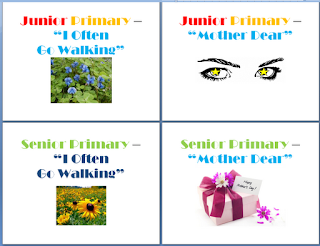I taught the primary children "The Dearest Names" for Father's Day. I had children raise their hand as the pianist played the tune, and realized that only about ten children out of the entire primary were familiar with the tune, which was just fine - by the end, they could all sing the song, and I think they had a good time learning the words.
Here's the outline of my lesson if you want to try it - honestly, it worked great and used way less materials than usual for me. In fact, I drew a flipchart for the junior primary and never even used it.
Here's the outline of my lesson if you want to try it - honestly, it worked great and used way less materials than usual for me. In fact, I drew a flipchart for the junior primary and never even used it.
1. I had the pianist play the entire song and asked children to raise their hand as they recognized the tune. This was basically a way for me to play the entire song for them one time.
2. I put a crossword puzzle up on the chalkboard that had answers to questions I wanted to ask them about the song, and then proceeded to ask the question. Children raised their hand as they found the answer to each question on the crossword puzzle. As they found each answer, I sang the line to the song, and then had them sing the line too. This gave me the opportunity to practice repetition with the song, but in a fun way mixed with a game.
Questions I asked were:
a) This song is about a very dear name. What is the dear name? (Father)
b) This song describes the name using three notes to say one word, like "beau-ti-ful" or "won-der-ful." What is that word? (Glorious)
c) This song describes Father with three words. What are those words? (Noble, and brave, and true)
d) What are the special words you say to Father? (I Love You)
(I had to leave out the crossword puzzle for junior primary, but asked the questions anyway. I felt like I lost some of the youngest children a little bit during this part until I got to item #3, but overall, it was still fine.)
3. I taught the children the sign for "name" (which I happened to know but it is pointing your index and middle finger on each hand, and tapping one on top of the other twice, in a "plus" sign - but hold your hand level, it just happens to look like a plus sign when you look down). I then told them to stand up and sign "name" every time they sang that part.
4. I taught the children the sign for "I Love You" and then told them to stand up, turn one way for "I," then turn again for "Love," then turn again for "You."
5. I also brought my bells, which I didn't have time to use in Junior Primary (I would have modified this and only passed out three bells to play, "I Love You"), but I had time to use them in Senior Primary. I asked each teacher to send up a reverent child from their class, and then drew names for some additional children. I then gave each child a bell, showed them how to read the musical chart I had made for them, and we played it one time through with the bells. They were a little messy the first time, so once they got the hang of it, I let them play the bells again, but this time I reminded the mesmerized children sitting in their seats to sing too. Then, I had time to ask the children to trade their bells with other children that were sitting down so they could try it too.
I found toward the end that children followed along more easily if I pointed to the word so they knew when to ring their bells, rather than expecting children to follow the words because they were singing them ... although, they did almost as well with the latter.
Credits:
While I made up most of this activity, the idea for #2 above, about the crossword puzzle with the matching questions, came from "A Children's Songbook Companion," by Pat Graham, Mary Gourley, Trudy Shipp, and Linda Stewart.







